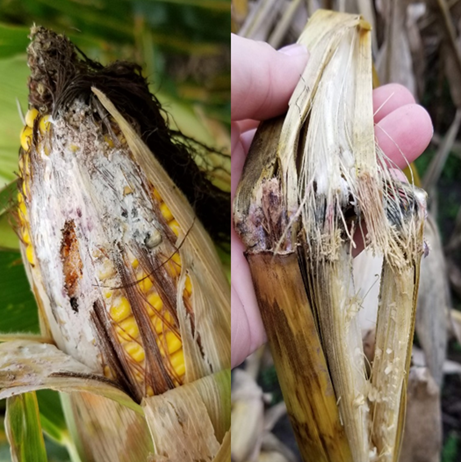
It is now time to evaluate fields for any stalk or ear rot symptoms. This will aid in making assessments about field harvest order and if there is a risk of mycotoxin contamination.


It is now time to evaluate fields for any stalk or ear rot symptoms. This will aid in making assessments about field harvest order and if there is a risk of mycotoxin contamination.

One of the more unusual issues showing up in Indiana corn fields this summer is “tassel wrapping”, a phenomenon where the uppermost leaves, including the flag leaf, remain tightly wrapped around the developing tassel (Figure 1).
As the crop advances into the V7–V10 stages, many areas of the state have experienced favorable conditions, with adequate moisture and the accumulation of growing degree days (GDDs) supporting rapid vegetative growth.

Recent storms and heavy rainfall brought on by the remnants of Hurricane Beryl have crossed parts of Indiana this week and brought excessive winds which has resulted in corn being “flattened” from lodging in certain areas of the state.
With planting now wrapped up nationwide, corn emergence is nearing completion across much of the Corn Belt. Emergence in Indiana has progressed well, reaching 89%, up from 81% the previous week, although it is still slightly behind the five-year average of 94%.

According to the USDA-NASS planting progress report released on June 9, 2025, 97% of the U.S. corn crop has been planted, a notable increase from 93% the previous week and at the same pace as the five-year average of 97% (Figure 1).

According to the USDA-NASS planting progress report released on June 2, 2025, 93% of the U.S. corn crop has been planted, a notable increase from 87% the previous week and matching the five-year average of 93% (Figure 1).

Planting wrapped up last week at the Pinney Purdue Agricultural Center (PPAC) in Wanatah, IN, and the week before at the Agronomic Center for Research and Education (ACRE) in West Lafayette, so our two main Purdue Corn Team research sites are in the ground and growing.

As of May 16, 2025, 62% of the U.S. corn crop has been planted, ahead of both last year’s pace (47%) and the 5-year average of 56% (Table 1). Favorable weather conditions last week allowed farmers across much of the Corn Belt and northern states to make strong progress. Southern states continue to lead progress, with Texas (84%), North Carolina (86%), and Tennessee (76%) nearing completion of early vegetative establishment. Across the Corn Belt, planting activity accelerated sharply. Iowa climbed to 76%, Minnesota reached 75%, and Nebraska advanced to 73%, all well ahead of their historical averages. Illinois also made significant gains, jumping from 32% to 54%. While Ohio (25%) and Wisconsin (44%) remain behind their average pace. Warmer temperatures and drier conditions are expected to support continued improvement in seedbed preparation, emergence, and early stand establishment in the coming weeks. In Indiana, the USDA-NASS report indicates that 45% of[Read More…]
In Indiana, the prime planting window for corn is from April 20 to May 10.
© 2025 Purdue University | An equal access/equal opportunity university | Copyright Complaints | Maintained by Pest&Crop newsletter
If you have trouble accessing this page because of a disability, please contact Pest&Crop newsletter at luck@purdue.edu.